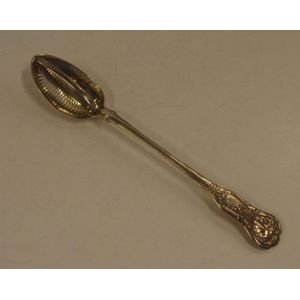Victorian Silver Sifting Spoon, London 1872, George Angell Maker
You must be a subscriber, and be logged in to view price and dealer details.
Subscribe Now to view actual auction price for this item
When you subscribe, you have the option of setting the currency in which to display prices to $Au, $US, $NZ or Stg.
- Angell Family of Silversmiths - There were a number of members of the Angell family who were silversmiths, commencing with Joseph Angell I (also expressed as Joseph Angell, Senior), and his brothers John Angell and Abraham Angell.
On the retirement of Joseph Angell I in 1948, from what had become the leading London silverware workshop, the business was taken over by his son, Joseph Angell II (also expressed as Joseph Angell, Junior), (1815 - 1891).
Joseph Angell II exhibited at the at the 1851 Great Exhibition, the 1853 New York Exhibition, and the 1862 International Exhibition winning medals at each event.
His career is marked by the rich silver items crafted and decorated with chiseling, reliefs and enamels, including trays, tea and coffee sets, jugs, centrepieces and vases
The Victoria and Albert Museum in London holds a number of silver objects by Jospeh Angell II. - Marrow Spoon - A spoon with a long handle and a narrow scoop shaped bowl, used to scoop and eat marrow from the hollow centre of roasted bones. Some marrow scoops are double ended with a different shaped bowl at each end.
- Victorian Period - The Victorian period of furniture and decorative arts design covers the reign of Queen Victoria from 1837 to 1901. There was not one dominant style of furniture in the Victorian period. Designers used and modified many historical styles such as Gothic, Tudor, Elizabethan, English Rococo, Neoclassical and others, although use of some styles, such as English Rococo and Gothic tended to dominate the furniture manufacture of the period.
The Victorian period was preceded by the Regency and William IV periods, and followed by the Edwardian period, named for Edward VII (1841 ? 1910) who was King of the United Kingdom and the British Dominions and Emperor of India for the brief period from 1901 until his death in 1910. - Hallmarks - A mark stamped on articles of precious metals in Britain, since the 14th century, certifying their purity. It derives its name from the Guild Hall of the Goldsmiths' Company, who recieved its Charter in 1327 giving it the power to assay (test the purity) and mark articles of gold and silver.
The hallmark will consist of several marks, including the:
- silver standard mark, indicating the purity of the metal. Sterling silver is .925 pure silver.
- the city mark indicating the city in which it was assayed eg London, Birmingham, York etc.
- the date mark, usually a letter of the alphabet in a particular font and case,
- a duty mark, indicating whether duty had been paid to the crown, and only in use from 1784 to 1890
The piece may include an additional mark, the maker's mark, although not forming part of the hallmark, will be located in the vicinity of the hallmarks.
Sometimes silver plated items will bear faux hallmarks, often confusing those not familiar with silver markings. - Sterling Silver - Sterling silver is a mixture of 92.5% pure silver and 7.5% of another metal, usually copper. Fine silver is 99.9% pure silver, and is relatively soft and the addition of the very small amount of copper gives the metal enough strength and hardness to be worked into jewellery, decorative and household objects.
This item has been included into following indexes:
Visually similar items

A Christofle silver sugar caster spoon, mid 19th century, with Cc and bee mark in oval cartouche, with a foliate pierced bowl and a shaped handle with reeded edges; with hallmarks and Christofle relief cartouche underside. Silver weight 65gr. Length 22 cm

An early Victorian fiddle pattern silver sugar sifting ladle, London 1857 by George Angel. Length 16.5 cm

Georgian sterling silver ladle, hallmarked London 1813, maker William Eley I, William Fearn & William Chawner II, 49grams approx

Victorian sterling silver straining spoon, in the Kings pattern. Hallmarked London 1839. W 220gms.
